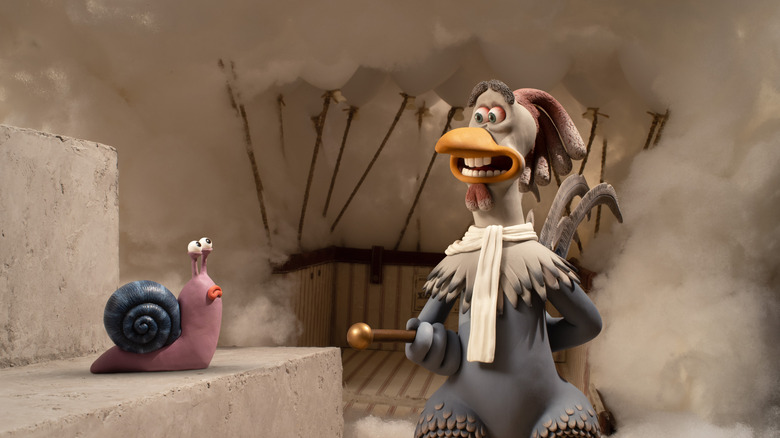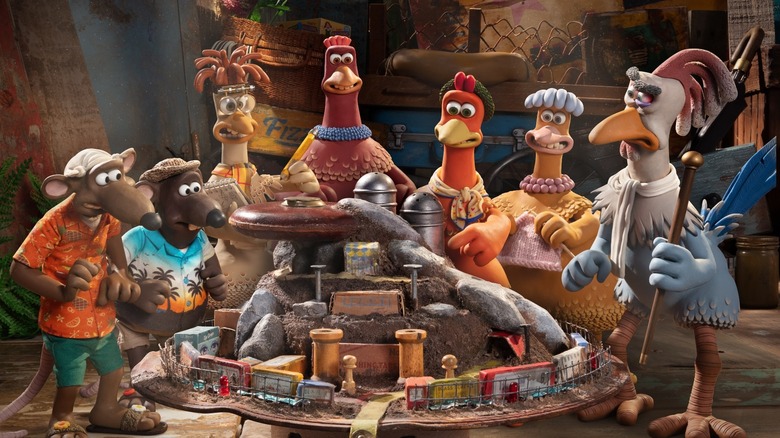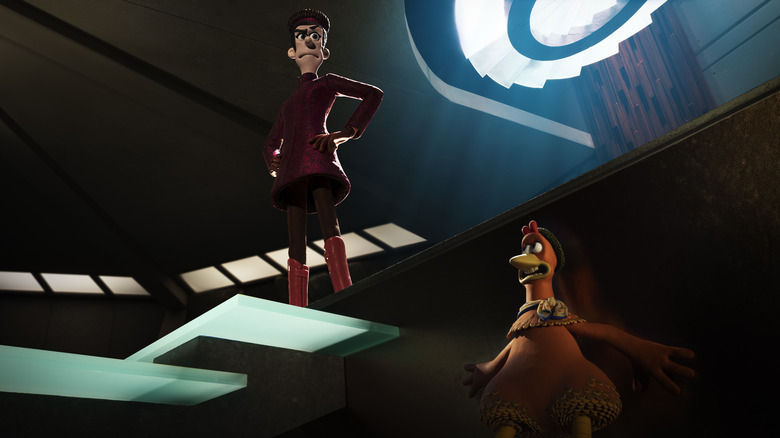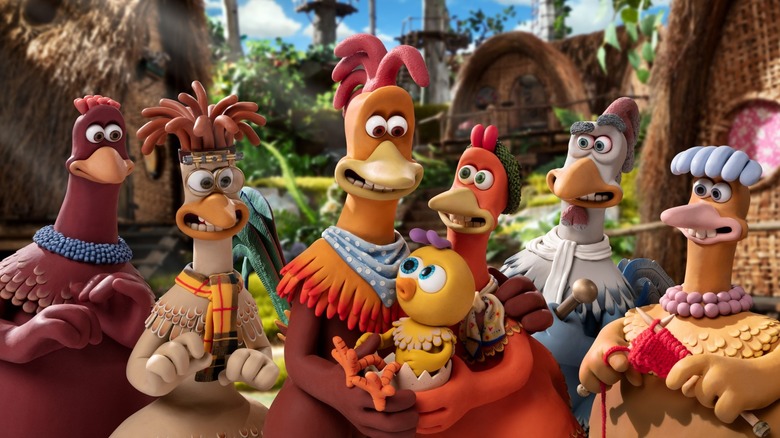Yes, Chicken Run: Dawn Of The Nugget Uses CGI – But You Probably Won't Notice [Set Visit]
As the end of the 20th century came to a close, traditional 2D animation seemed to be dying along with it. But while Disney Renaissance films are often remembered by nostalgic Millennials as the last great ride of hand-drawn animation, their grand, sweeping scale was actually made possible by blending old-school techniques with brand new technology. In the ballroom scene from 1991's "Beauty and the Beast," a hand-drawn Belle and Beast waltz against the spinning backdrop of a CG-animated ballroom; the heart-stopping stampede in 1994's "The Lion King" has a traditionally-animated Simba fleeing from computer-animated wildebeest.
The balance soon tipped over in favor of the completely CG animation that dominates today. But somewhere between the release of "Toy Story" and "Shrek," a British studio called Aardman Animations ambitiously embarked on its first feature film: a poultry-themed spin on "The Great Escape" called "Chicken Run." With a final tally of $227.7 million at the global box office, it was the highest-grossing stop-motion animated feature in history, and it still hasn't been beaten.
"It flew the flag for stop motion in a really big way," director Sam Fell told me when I visited the set of the upcoming sequel, "Chicken Run: Dawn of the Nugget," which is due to hatch on Netflix next month. "['Chicken Run'] showed that you could reach a wide audience with a stop-motion film, it doesn't have to be niche."
And so, while "Antz" was battling "A Bug's Life" in the new CGI landscape, the oldest methods of 3D animation — still cameras capturing individual frames of puppets and clay figures — continued to thrive at studios like Aardman and Laika. But if a touch of digital effects can breathe terrifying life into a wildebeest stampede, how might it enhance a stop-motion world?
A whole new world
If the headline has you worried that the little chickies you see in "Chicken Run: Dawn of the Nugget" exist only on a computer hard drive, let me reassure you that I have held the little chickies in my hand (including an adorable baby Molly, the offspring of Rocky and Ginger from the first "Chicken Run"). In fact, what I saw of the animation process was largely the same as it had been when I visited the set(s) of "The Pirates! In an Adventure with Scientists!" inside the same building in Bristol, England, 13 years earlier.
Even back then, Aardman had already begun to incorporate CGI into its animation. "I don't worry about theoretical purity," Aardman co-founder Peter Lord explained in an interview with Wired at the time. "I just want to hear the technician at my shoulder saying, 'I can do that' — and you know they will. What charms me is being able to take our handmade world and make it bigger; free it up a bit."
Those handmade worlds aren't quite to scale, but they are massive: built on elevated stages and decorated with painstaking detail. "Dawn of the Nugget" contrasts the messy comfort of the chickens' island sanctuary ("Chicken Wakanda," as director Sam Fell calls it) with the sinister artificial smoothness of Chicken Funland (Fell: "Chicken Butlin's"), a new "free range" chicken farm operated by the villainous Mrs. Tweedy. Other sets explore "Chicken Wakanda" in greater detail, like a tree branch built specifically for a moment where the camera follows Molly as she runs up to her lookout post in the treetops.
So, if the sets are still solid and Babs' knitting is still made of real wool, where does the CGI come in? Well, mainly when the time comes to fit it all together.
The chicken scale problem
No, "chicken scale" is not a skin disease that afflicts chickens. (Actually, it might be; I'm not a chicken expert.) In "Chicken Run: Dawn of the Nugget," chicken scale is the default view of the world, but that world unfortunately also contains humans like Mrs. Tweedy. The chicken models used on set are small enough to be held in one hand, though expensive enough that you'd be wise to hold them with both hands, very carefully. If Mrs. Tweedy was built at that same scale, her silicone-and-clay model would have to be about six feet tall, which would be both a costly and impractical use of materials and, frankly, a terrifying thing to behold.
So, Mrs. Tweedy was built at the same size as the chickens, but "Dawn of the Nugget" has numerous scenes where humans interact with chickens, as well as locations that are used by both human and chicken characters. Again, building a human-scale duplicate of a chicken-scale set would take up an enormous amount of space, and real estate in Bristol is notoriously unaffordable, so the size of both the characters and the sets was made flexible through a technology that Aardman has dubbed "virtual production."
In many shots the sets are computer-generated but, importantly, they're not computer-originated. All of the digital elements in the film were first built in the real world and then 3D-scanned. A similar technique was used by Chilean animation studio Punkrobot for the "Star Wars: Visions" short "In the Stars," which is entirely computer animated but has the appearance of traditional stop motion because the characters were created from 3D scans of real, hand-painted models.
For complex shots in "Dawn of the Nugget," foreground elements like the chicken and human characters were shot against blue screens and embedded in virtual sets created from 3D scans of their real-world twins. On set, animators can see a live version of the composited shot on a monitor or through VR goggles. The sets can be sized up to human scale and then down to chicken scale, and when humans and chickens cross paths, the elements of the shot can be animated separately and then blended together. It expands the scope of what shots are possible in this ambitious heist story, but to the audience everything still looks real — because it is real.
Keeping the home fires of stop motion burning
Backstage at Aardman, assistant animators were doing essential prep work on the 5000-plus clay mouths (and beaks) used to animate the characters' dialogue. These are neatly organized into cardboard trays that resemble pizza takeout boxes, and labeled by the sound they're associated with (a rounded mouth for an "Oh" sound; clenched teeth for a "T"). There are more than a dozen duplicate sets for key characters so that a new set of mouths can be brought in while the old pizza box is returned and the mouths are cleaned, shaped, and reset.
Staring into these rows of lips and teeth all day seems like enough to drive a person mad. In that regard, it's the perfect way to train for the maddeningly slow craft of stop motion, where animators can expect to produce just three seconds of animation on a typical day. Not everyone can hack it, but those who can tend to stick around for a long time. Though almost three decades have passed since development began on the first "Chicken Run" film, many of the original crew returned to work on the sequel. "Dawn of the Nugget" director Sam Fell directed a single shot of the original "Chicken Run" (Rocky riding his tricycle over a hill). Charles Copping was a camera assistant on the first film; for the sequel, he's the director of photography.
The knowledge and skillset required for stop motion is niche enough that it could easily be lost within a generation or two if the masters weren't constantly passing on what they know to young apprentices. Aardman's studio at Aztec West has the feel of a training ground, where the assistant animators of today are molded into the animation supervisors of tomorrow. Hannah Brooks, who was overseeing the restoration of the returning beaks, was hired as a trainee on "Early Man" straight out of university and has since risen to the role of supervising assistant animator on "Dawn of the Nugget."
The sequel is a particular challenge, Brooks explained, because "it has to look the same" as the original film despite different materials (the bodies were made of clay in "Chicken Run," but Aardman found that clay fingers have a nasty tendency to snap off, and now builds silicone bodies with clay heads). And that character continuity also has to be married with the creative vision of a new director. "What Nick [Park, co-director of 'Chicken Run'] would have wanted is not what Sam would have wanted," Brooks said. "But they have to look like the same character."
It's not easy to find a balance between old and new. But then again, nothing about stop motion is easy.
"Chicken Run: Dawn of the Nugget" releases December 15, 2023, on Netflix.



